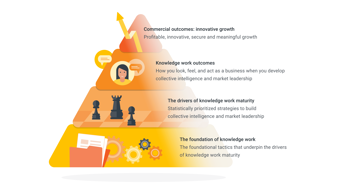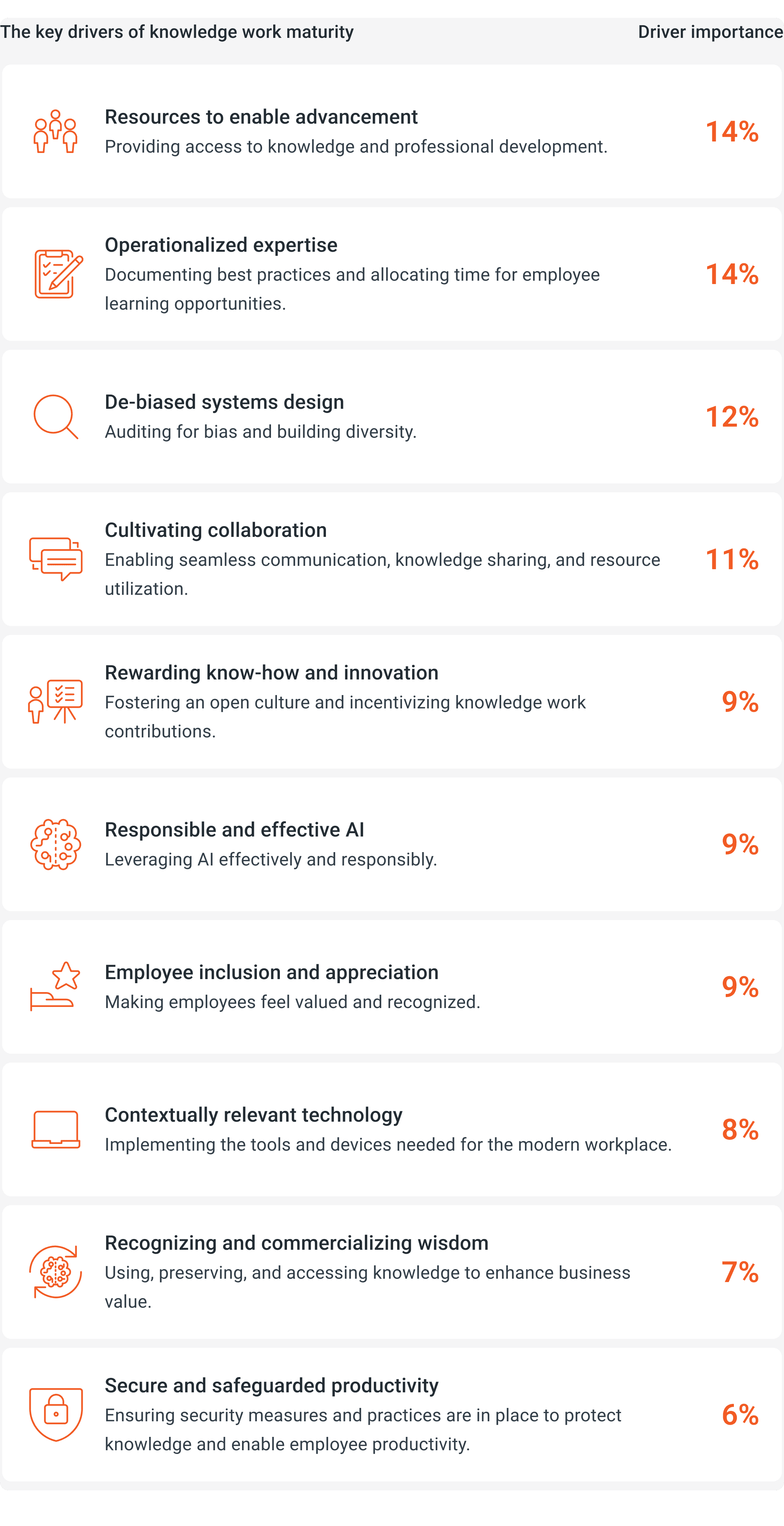Ten knowledge work strategies to drive advantage

In part one, we talked about WHY the knowledge work industry is undergoing radical change and concluded that the future of work is knowledge work, and the future of knowledge work is collective intelligence.
Part 2 reveals HOW Knowledge Work Organizations like yours can apply ten statistically proven strategies that can drive collective intelligence in your organization.
The insights shared are based on analyses of over 500,000 global digital conversations, survey data drawn from 2,000 global respondents, and one-to-one in-depth interviews with 29 subject matter experts.
Every respondent works in an organization operating in the knowledge economy, which relies on digital documents containing IP that require protection and governance.
These organizations can be businesses, e.g., Legal Firms, Tax Firms, Accountancy Firms, or specialist teams within businesses, e.g., corporate law, corporate finance, procurement, HR, etc. We refer to these as Knowledge Work Organizations (KWOs)
Explore this page
Moving from managing knowledge to knowledge work maturity
Are you forced to debate which technologies, processes, and cultural behaviors, will take your KWO from managing knowledge to making knowledge work? Do you find it hard to get support for the investment that you want to make? Yes?
Then it’s time to put a stake in the ground and define what it means to be a mature KWO.
Until now, approaches to knowledge work have been scattered, and technical and business leaders have been left to take “best guesses” at how to support their knowledge workers and activate knowledge.
There’s been a lack of clarity around what works: which technologies, processes, and cultural behaviors, take companies from managing knowledge to making knowledge work? The Knowledge Work Maturity Model™ is designed to statistically answer this question.
The Knowledge Work Maturity Model™ was commissioned by iManage and created by Metia, an independent research, analytics, and marketing firm. It was specifically created to provide a robust, data-driven blueprint for global knowledge work maturity.
What does knowledge work maturity mean?
There are four components that make up the Knowledge Work Maturity Model™
How knowledge work matures

At the top of the pyramid is the business impact of investing in knowledge work - the tangible, market value of behaving as KWO. Business outcomes include superior customer and employee experience that allow you to drive new revenue, increase billable hours, increase the billable rate for higher value work and drive overall profitability.
Layer two represents the two key knowledge work outcomes that will accelerate your commercial growth, i.e., experiencing the benefits of collective intelligence and being an industry leader and organization that people want to work for and do business with.
The third layer is made up of ten statistically validated, prioritized knowledge work strategies to deliver collective intelligence and market leadership.
The final foundational layer is made up of specific tactics that allow you to implement and consistently execute the ten key strategies in the layer above.
Today, we are focused on the second and third layers of the story.
The Knowledge Work Maturity Model™ methodology in a nutshell
Statistical analysis revealed two knowledge work outcomes, collective intelligence and industry leadership, which are represented by the three research statements that most accurately define and predict knowledge work maturity:
Collective intelligence
Agree: The benefits of collective intelligence are fully realized.
Industry leadership
Agree: Other companies look at this company as an example of being knowledge-driven.
Agree: Knowledge workers would recommend this company to other knowledge workers.
If you are experiencing these to any degree, you are on the pathway to Knowledge Work Maturity. The more you experience them, the more mature, secure, effective and profitable you are as a KWO. The more you experience them, the more mature, secure, effective, and profitable you are as a KWO.
The model calculates each KWO’s score on the ten key drivers of knowledge work, correlates them with the outcomes, and accurately predicts each KWOs overall knowledge work maturity level.
This allows you to benchmark, compare and create a clear path for investment.
10 key strategies to drive knowledge work maturity
There are ten statistical drivers of Knowledge Work Maturity. Think of these as the core strategies that you need to put in place to thrive as a KWO.
The 10 drivers of knowledge work maturity

Strategy 1: resources to enable advancement
Providing access to knowledge and professional development.
Recognize the role of EQ in knowledge work - value intuition. Empower experts to contribute across the business, collaborating, supporting, and advising outside of traditional silos.
This driver is about whether you provide clear career pathways, mentorship programs, and access to data and training about the company, customers, and the market. It assesses if you operate a meritocracy and offer opportunities to grow at all levels of the organization.
Strategy 2: Operationalized expertise
Documenting best practices and allocating time for employee learning opportunities.
This reflects the extent to which you’re seen to invest in your people. It’s about how effectively you document best practices for knowledge working, provide opportunities for employees to learn, and apply cross-functional knowledge in your organization. A key component is ensuring that there’s formal time allocated for knowledge documentation, and you share your customer experience design with employees, partners, and other stakeholders so everyone is aligned on how to best serve your clients.
Strategy 3: De-biased systems design
Auditing for bias and building diversity.
This driver measures how well your organization audits their communications, job descriptions, and algorithms for bias, as well as the extent to which you consult a diverse body of knowledge workers to help define what success looks like.
It represents a commitment to embrace diverse voices, thoughts, experience, and identities not only to deliver work but to define their business goals and make strategic decisions.
Strategy 4: Cultivating collaboration
Enabling seamless communication, knowledge sharing, and resource utilization.
This is about how well teams and individuals can proactively share knowledge, search for relevant knowledge by task, and efficiently outsource tasks when they can’t be accomplished by internal teams. It starts with better processes and technology and results in a fully collaborative work culture.
Strategy 5: Rewarding know-how and innovation
Fostering an open culture and incentivizing knowledge work contributions.
This key driver is about how effectively you’re building a culture that’s committed to recognizing, celebrating, and financially incentivizing innovation, diversity, learning, and the sharing of knowledge at all levels in your organization.
For example, if things don’t work out as planned, you view it as a learning moment, not a failure. You protect established knowledge, make room for new and innovative perspectives, and meld legacy and new approaches to build exponential value.
Strategy 6: Responsible and effective ai
Leveraging AI effectively and responsibly.
Leverage AI where appropriate to automate workflows allowing employees to focus on value-added tasks. Where AI is implemented, ensure ethical best practice is supported with employee training.
There’s a phase in KWOs’ maturity where AI becomes a reality. The driver measures where you are in the process, from establishing a strategy to implementing the basics like automating simple workflows to advanced AI functionalities that are allowing employees to focus on value-added tasks. An important component is the extent to which you foster an ethical approach to the use of AI and ensure all employees understand how to use it.
Strategy 7: Employee inclusion and appreciation
Making employees feel valued and recognized.
Ensure specific expertise is understood, and valued organization wide. Recognize that different skills and perspectives are strengths. Celebrate knowledge, celebrate success, and ensure remuneration reflects where people make unique contributions. Value people as individuals, not just the work they produce.
This measures how much you value expertise in multiple forms. It includes your ability to recognize different skills and perspectives as an organizational strength together with your commitment to celebrate knowledge and ensure that you recognize the unique contributions that people make. It’s about valuing people as individuals, not just for the work they produce.
Strategy 8: Contextually relevant technology
Implementing the tools and devices needed for the modern workplace.
This measures how effectively you’re investing in the right technology to provide rapid access to critical information and shared knowledge. Do you have a modern IT infrastructure that meets the expectations of modern knowledge worker, and do you keep it up to date and relevant? Do you consult employees on the work devices you issue?
Strategy 9: Recognizing and commercializing wisdom
Using, preserving, and accessing knowledge to enhance business value.
This reflects the degree to which you’re using your preserved knowledge to support your business goals, such as profitability, productivity, market leadership, and growth.
It also involves recognizing the role of emotional intelligence (EQ) in knowledge work, valuing employees’ intuition, and empowering experts to contribute across the organization by collaborating, supporting, and advising outside of traditional silos.
It’s about your culture of sharing and the ability to quickly get access to the people and knowledge that you need.
Strategy 10: Secure and safeguarded productivity
Ensuring security measures and practices are in place to protect knowledge and enable employee productivity.
The foundation of successful knowledge work is a safe environment in which to store, share, work, and collaborate on documents. You need a culture of security that protects the knowledge and IP of the company while letting people still work efficiently. This is about making sure employees can securely access company knowledge resources and be productive wherever and whenever they need to.
Do I need to focus on all 10?
The short answer – it depends on where you are today, your ambition and your readiness to invest.
The more you can do, do well and do consistently under each strategy, the closer you will get to collective intelligence, market leadership and commercial outcomes like growth in profitability, productivity, billable hours and building sustained competitive advantage.
The good thing is, no matter where you are today, you can choose to go at your own pace.
Why not start your journey right now by asking yourself four basic questions:
- How many of the critical 10 knowledge work maturity strategies do you have in place today?
- How would you score yourself on each of the strategies – 1 = weak, 10 = market leading?
- Based on the scoring, where do you feel your strengths are today?
- And where are your obvious gaps?
Hint: Your answers will be important when you start to explore the details of the Knowledge Work Maturity Model™ so it’s worth writing them down.
Research Report
The Knowledge Work Maturity Model
An industry-first research study to understand knowledge work maturity and the strategies it takes to unlock better business outcomes.
